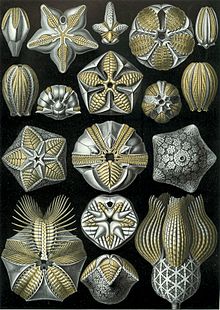Bud radiator
| Bud radiator | ||||||||||||
|---|---|---|---|---|---|---|---|---|---|---|---|---|

Pentremites |
||||||||||||
| Temporal occurrence | ||||||||||||
| Silurian (Wenlock) to Perm | ||||||||||||
| 428 to 248 million years | ||||||||||||
| Locations | ||||||||||||
|
||||||||||||
| Systematics | ||||||||||||
|
||||||||||||
| Scientific name | ||||||||||||
| Blastoid | ||||||||||||
| Say , 1825 |
The bud radiators (Blastoidea from ancient Gr. Βλαστός 'stem') are an extinct class within the echinoderma tribe and are distantly related to the sea lilies and hair stars (class Crinoidea , sub-tribe Crinozoa) that are still alive today . In the systematics, the bud radiators with around 80 genera are grouped together with the other extinct classes Eocrinoidea , Cystoidea (bag radiator), Paracrinoidea and Parablastoidea in the sub- strain Blastozoa .
The origin of the bud radiators is unclear, a descent from the Eocrinoidea or Ordovician cystoidea is being considered. From the Silurian onwards , both main groups ( Fissiculata and Spiraculata ) were represented. The Fissiculata were rich in forms in the Devonian and Lower Carboniferous ; they had their main flowering period in the Permian . The Spiraculata became more and more rich in shape in the Devonian and had their main flowering period in the Lower Carboniferous. Only a few stragglers reached into the Permian.
Most blastoids - like the crinoids - had a body capsule (theka) sitting on a stem, which consisted of tablets and formed a rigid shell. Typical of the blastoids were the hydrospires, a characteristic system of (assumed) respiratory openings in the upper area of the theca. Many brachioles , essentially consisting of two alternating rows of plates, were attached to the theka .
Cover slips, stems and brachiola slides quickly detached themselves from the theca after the death of the individual and were often embedded in isolation. They can hardly be distinguished from the corresponding elements of the Crinoideen and are usually incorrectly addressed as "Crinoideen-Schill".
They are particularly common in the Lower Carboniferous of North America and in the Permian of Timor Island .
Way of life
The Blastoid were exclusively marine and subsisted by fressbare particles with their Brachiolen from the passing water filtered and brought to the mouth. Most of the bud radiators were - like sea lilies - permanently attached to the seabed with a stalk ( sessile ).
literature

- Bernhard Ziegler: Introduction to Paleobiology Part 3 . ISBN 3-510-65179-0
- Treatise of Invertebrate Paleontology: Part S Echinodermata 1 . ISBN 0-8137-3020-1
- Ulrich Lehmann, Gero Hillmer: Invertebrates of the past . ISBN 3-432-90653-6
